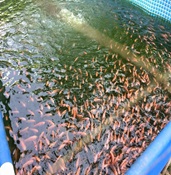Cultivo de tilapia con efluente de tanque séptico-laguna de alta tasa: pulimento para tratamiento de aguas residuales domésticas y recuperación de recursos
Contenido principal del artículo
En un experimento a escala piloto desarrollado en Brasil, se cultivaron juveniles de tilapia genéticamente mejorada en efluente de tanque séptico seguido de laguna de alta tasa (LAT). Durante las 22 semanas de la investigación se evaluó la combinación de tres tasas de aplicación superficial de nitrógeno amoniacal total (NAT) (0,6; 1,2 y 2,4 kg NAT.ha-1.d-1) y tres densidades de cultivo (3; 6 y 12 peces.m-2). Los tanques de cultivo funcionaron como unidades de pulimento para tratamiento de las aguas residuales, adicionando (con los mejores resultados, alcanzados con la menor densidad de cultivo y 1,2 kg NAT.ha-1.d-1) las siguientes eficiencias de remoción adicionales a las obtenidas mediante el uso de la LAT: 78,3% para nitrógeno total Kjeldahl; 89,1% para nitrógeno amoniacal; 63,9% para fósforo total; 57,2% para demanda química de oxígeno; 2,36 unidades logarítmicas para E. coli. La productividad de los peces se estimó del orden de 2,67 ton.ha-1 para cultivo durante seis meses por año para climas templados, utilizando la población de plancton natural del agua residual doméstica tratada como la única fuente de alimento.
- Lagunas de alta tasa
- Tanque séptico
- Piscicultura con aguas residuales
- Cultivo de tilapia
- Reúso de agua
Adhikari JR, Lohani SP. Design, installation, operation and experimentation of septic tank - UASB wastewater treatment system. Renew. Energ. 2019;143:1406–1415. Available from: https://doi.org/10.1016/j.renene.2019.04.059 DOI: https://doi.org/10.1016/j.renene.2019.04.059
Tan X-B, Wang L, Wan X-P, Zhou X-N, Yang L-B, Zhang W-W, Zhao X-C. Growth of Chlorella pyrenoidosa on different septic tank effluents from rural areas for lipids production and pollutants removal. Bioresource Technol. 2021;339:125502. Available from: https://doi.org/10.1016/j.biortech.2021.125502 DOI: https://doi.org/10.1016/j.biortech.2021.125502
Buchanan NA, Young P, Cromar NJ, Fallowfield HJ. Performance of a high rate algal pond treating septic tank effluent from a community wastewater management scheme in rural South Australia. Algal Res. 2018;35:325–332. Available from: https://doi.org/10.1016/j.algal.2018.08.036 DOI: https://doi.org/10.1016/j.algal.2018.08.036
Craggs R, Sutherland D, Campbell H. Hectare-scale demonstration of high rate algal ponds for enhanced wastewater treatment and biofuel production. J. Appl. Phycol. 2012;24:329-337. Available from: https://doi.org/10.1007/s10811-012-9810-8 DOI: https://doi.org/10.1007/s10811-012-9810-8
Kumar D, Hiremath AM, Asolekar SR. Integrated management of wastewater through sewage fed aquaculture for resource recovery and reuse of treated effluent: A case study. APCBEE Procedia. 2014;10:74–78. Available from: https://doi.org/10.1016/j.apcbee.2014.10.019 DOI: https://doi.org/10.1016/j.apcbee.2014.10.019
Kumar D, Chaturvedi MKK, Sharma SK, Asolekar SR. Sewage-fed aquaculture: a sustainable approach for wastewater treatment and reuse. Environ. Monitor. Assess. 2015;187:656. Available from: https://doi.org/10.1007/s10661-015-4883-x DOI: https://doi.org/10.1007/s10661-015-4883-x
Waite R, Beveridge M, Brummett R, Castine S, Chaiyawannakarn N, Kaushik S, Mungkung R, Nawapakpilai S, Phillips M [Internet]: World Resources Institute: 2014. Improving productivity and environmental performance of aquaculture. Creating a Sustainable Food Future, (June), 2014. Available from: https://files.wri.org/d8/s3fs-public/WRI14_WorkingPaper_WRR5_final.pdf
Gabriel NN. Review on the progress in the role of herbal extracts in tilapia culture, Cogent Food Agric. 2019;5:1619651. Available from: https://doi.org/10.1080/23311932.2019.1619651 DOI: https://doi.org/10.1080/23311932.2019.1619651
Sánchez IA, Bastos RKX, Lanna EAT. Tilapia rearing with high rate algal pond effluent: ammonia surface loading rates and stocking densities effects. Wa. Sci. Technol. 2018;78(1):49-56. Available from: https://doi.org/10.2166/wst.2018.285 DOI: https://doi.org/10.2166/wst.2018.285
Bastos RKX, Pereira CM, Pivelli RP, Lapolli FR, Lanna EAT. Utilização de esgotos sanitários em piscicultura, In: Bastos RKX, coordinador. Utilização de esgotos tratados em fertirrigação, hidroponia e piscicultura – Projeto PROSAB. Rio de Janeiro-Brazil: ABES, RiMa; 2003. p. 193-221.
Edwards P, Sinchumpasak OA, Tabucanon M. The harvest of microalgae from the effluent of a sewage fed high rate stabilization pond by tilapia nilotica Part 2: Studies of the fish ponds. Aquaculture. 1981;23(1-4):107-147. Available from: https://doi.org/10.1016/0044-8486(81)90010-7 DOI: https://doi.org/10.1016/0044-8486(81)90010-7
APHA, AWWA, WEF. Standard methods for the examination of water and wastewater, 22th ed. Washington DC, USA:American Public Health Association/American Water Works Association/Water Environment Federation. 2012.
Young P, Taylor M, Fallowfield HJ. Mini-review: high rate algal ponds, flexible systems for sustainable wastewater treatment. World J. Microb. Biot. 2017;33(6):117. Available from: https://doi.org/10.1007/s11274-017-2282-x DOI: https://doi.org/10.1007/s11274-017-2282-x
Assemany PP, Calijuri ML, Couto EA, Batalha MH, Silva NC, Santiago AF, Castro JS. Algae/bacteria consortium in high rate ponds: Influence of solar radiation on the phytoplankton community. Ecol. Eng. 2015;77:154–162. Available form: https://doi.org/10.1016/j.ecoleng.2015.01.026 DOI: https://doi.org/10.1016/j.ecoleng.2015.01.026
Reed SC, Bastian RK, Jeweil W. Engineering assessment of aquaculture systems for wastewater treatment: an overview. In: Bastian RK, Reed SC, Project Officers. Aquaculture systems for wastewater treatment: Seminar proceedings and engineering assessment. Washington DC, USA: Environmental Protection Agency EPA; 1979. p. 1-12.
Meadows BS: Fish production in waste stabilization ponds. In: Cotton A, Pickford J, editors. Proceedings of the 9th WEDC International Conference Sanitation and water for development in Africa. Harare, Zimbabwe; 1983. p. 39-42.
Balasubramanian S, Pappathi R, Raj SP. An energy budget and efficiency of sewage-fed fish ponds. Bioresource Technol. 1995;52(2):145-150. Available from: https://doi.org/10.1016/0960-8524(95)00015-7 DOI: https://doi.org/10.1016/0960-8524(95)00015-7
Freitas AS. Utilização de esgotos sanitários tratados em lagoas de polimento para a criação de alevinos de tilápia do Nilo-aspectos produtivos e econômicos. [dissertação de mestrado]. Viçosa, Brazil: Universidade Federal de Viçosa; 2006.
Sin AW, Chiu MLT. The culture of tilapia (Sarotherodon mossambica) in secondary effluents of a pilot sewage treatment plant. Resour. Conserv. 1987;13(2-4):217-229. Available from: https://doi.org/10.1016/0166-3097(87)90064-2 DOI: https://doi.org/10.1016/0166-3097(87)90064-2
Silva FJA, Mara DD, Pearson HW, Mota SE. Informal fish culture in the Maracanaú waste stabilization ponds in Fortaleza, Brazil. Water Sci. Technol. 2000;42(10-11):393–398. Available from: https://doi.org/10.2166/wst.2000.0687 DOI: https://doi.org/10.2166/wst.2000.0687
Abdul-Rahaman I, Owusu-Frimpong M, Ofori-Danson PK. Sewage fish culture as an alternative to address the conflict between hunters and hunting communities in Northern Region. Journal of Agriculture and Sustainability. 2012;1(1):1-22.
Descargas

Esta obra está bajo una licencia internacional Creative Commons Atribución-NoComercial-CompartirIgual 4.0.
Los autores que publican en esta revista están de acuerdo con los siguientes términos:
Los autores ceden los derechos patrimoniales a la revista y a la Universidad del Valle sobre los manuscritos aceptados, pero podrán hacer los reusos que consideren pertinentes por motivos profesionales, educativos, académicos o científicos, de acuerdo con los términos de la licencia que otorga la revista a todos sus artículos.
Los artículos serán publicados bajo la licencia Creative Commons 4.0 BY-NC-SA (de atribución, no comercial, sin obras derivadas).


 https://orcid.org/0000-0001-7579-5969
https://orcid.org/0000-0001-7579-5969  https://orcid.org/0000-0001-6781-9617
https://orcid.org/0000-0001-6781-9617 https://orcid.org/0009-0002-0730-7999
https://orcid.org/0009-0002-0730-7999 https://orcid.org/0000-0003-3473-4996
https://orcid.org/0000-0003-3473-4996


